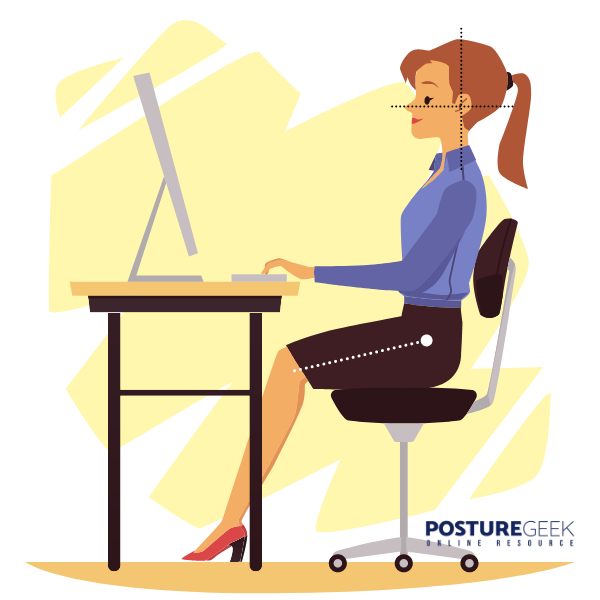Posture Headaches: What You Need to Know
The vast majority of headaches are not a sign of a severe underlying condition, but they can be very debilitating. For some people, pain can also be quite painful and interfere with daily activities.
PostureGeek.com Tweet

Headaches are one of the most common reasons people see their doctor. In fact, about 1 in 6 adults in the United States suffer from headaches. Neck pain is also quite common, with about 1 in 4 adults experiencing it at some point in their lives.
While the exact cause of migraines is unknown, they are thought to result from changes in the brainstem and its interaction with the trigeminal nerve, which is responsible for sensation in the face and head.
Neck pain, on the other hand, can be often caused by muscle tension or strain resulting from poor posture or injury.
The vast majority of headaches are not a sign of a severe underlying condition, but they can be very debilitating. For some people, pain can also be quite painful and interfere with daily activities.
Vertebrae that are misaligned and do not move correctly with their neighbours in response to the body’s demands can cause neck pain and migraines. This often happens due to poor posture, which can result from working at a computer all day, not getting enough exercise, or sleeping in an uncomfortable position.
Can you get headaches from bad posture?
The short answer is, YES.
There is a relationship between posture and frequent headaches because incorrect posture can lead to tension headaches and migraines. On the other hand, when you have good posture, your muscles are balanced and don’t have to work as hard. This can help prevent headaches because your muscles aren’t as likely to get tense and tight. Also, improving the position of the head and neck to align more with the shoulders and spine can help reduce the amount of strain on these muscles and joints, which can also lead to headaches.

What are the symptoms of posture related headaches?
The most common symptom of a posture headache is a pain in the neck, shoulders, and head. The pain is often described as tightness or pressure, and it can be mild to severe. Other symptoms may include:
Tension Headaches:
These are the most common types of headaches, often caused by muscular tension or strain. Symptoms include dull, achy pain, pressure, and tightness.
Cluster headaches:
These are severe headaches that come in groups or clusters. They are often described as burning or piercing pain. Other symptoms may include redness in the eye, sweating, and a runny nose.
Migraines:
These are headaches that can cause severe pain, nausea, vomiting, and sensitivity to light and sound.
How are posture related headaches treated?
The best way to treat headaches is to prevent them in the first place. This means correcting your posture and practising good ergonomics.
If you already have a headache, you can do a few things to ease the pain. Over-the-counter pain relievers like ibuprofen or acetaminophen can help. Applying ice or heat to the sore muscles can also be helpful. However, if your headaches are severe or frequent, you may need to see a doctor or other recognized health care provider for additional treatment.
What are the best ways to prevent posture related headaches?

The best way to prevent posture headaches is to practice good posture and ergonomics. This means keeping your head up and your shoulders back when sitting or standing. It’s also essential to take regular breaks if you’re working at a computer or doing another activity that requires you to be in one position.
Exercise is also vital for preventing posture headaches. Strong muscles help support your spine and keep your posture in alignment. Stretching can also help reduce muscle tension and pain.
How do you get rid of a headache from bad posture?
To get rid of a headache caused by incorrect posture, you need to fix your posture. This may sound difficult, but there are some strategies you can use to help you on your way.
Here are a few things you can do to improve your posture and get rid of your headaches:
Stand up straight.
When you stand, imagine there is a string attached to the top of your head. This will help you keep your spine straight and avoid slouching.
Sit up straight.
Make sure your back is against the chair, and your feet are flat on the floor when you sit. Avoid crossing your legs or hunching over.
Walk tall.
When you walk, hold your head up and keep your shoulders back.
Use good posture when you sleep. Sleeping on your back with a pillow under your knees is ideal. If you sleep on your side, use a pillow between your legs.
Avoid Text Neck.
With the increased use of technology the head and neck can be heavily influenced by where you place your device. Hold it up when you look at your phone or another screen, so you don’t have to crane your neck. This will help avoid strain on muscles and joints.
If you have issues with your posture, it’s important to correct it as soon as possible. It will help get rid of your headaches, but it will also help prevent other health problems in the future.
Can a misaligned neck cause headaches or migraines?

Yes, a misaligned neck can often be the cause of headaches and migraines. When your neck is out of alignment, it puts pressure on the nerves and muscles in your neck. This can lead to tension headaches and migraines. In addition, the head’s relative weight and position can be influenced bythe effects of gravity.
How do neck and shoulder muscles influence headaches?
The muscles in the neck and shoulders can influence headaches because they are connected to the head and spine. When these muscles are tight or out of alignment, it can cause tension headaches and migraines.
Stretching and massage can help relieve the tension in these muscles and improve the alignment of the neck and shoulders. This can help reduce the frequency and severity of headaches.
Can forward head posture cause headaches?
Yes, forward head posture can cause tension headaches and migraines. As mentioned above the effects of gravity can influence how pressure is felt throughout the head, neck, and shoulders. When your head is positioned too far forward, it puts extra pressure on the muscles and nerves in your neck. This can lead to tension headaches and migraines.
Finally
Fortunately, most of the neck discomfort and headaches caused by poor posture may be relieved with simple techniques. In addition, physical treatment can help relieve muscular and strength imbalances symptoms and teach and instruct individuals to modify their posture.
Poor posture can lead to several health problems, including tension headaches and migraines. Luckily, you can do a few things to improve your posture and get rid of these headaches. For example, stand up straight, sit up straight, walk tall, and use good posture when you sleep.
Avoid text neck by holding your phone or other screens at eye level. If you have poor posture, it’s essential to correct it as soon as possible to avoid further health problems.
PLEASE NOTE
PostureGeek.com does not provide medical advice. This information is for educational purposes only and is not intended to be a substitute for professional medical attention. The information provided should not replace the advice and expertise of an accredited health care provider. Any inquiry into your care and any potential impact on your health and wellbeing should be directed to your health care provider. All information is for educational purposes only and is not intended to be a substitute for professional medical care or treatment.
